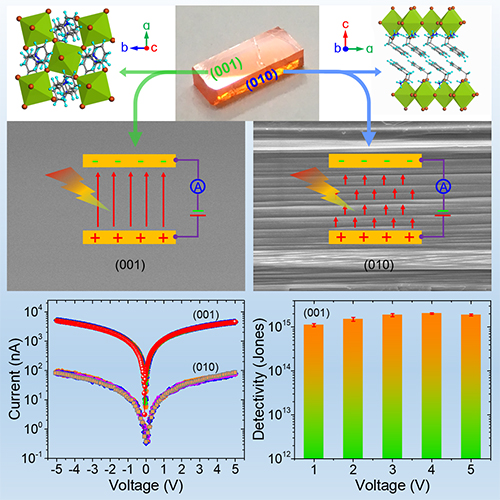A research group led by Prof. LIU Shengzhong from the Dalian Institute of Chemical Physics (DICP) of the Chinese Academy of Sciences and Dr. XU Zhuo at Shaanxi Normal University (SNNU) developed a technique to prepare large size 2D perovskite single crystals to achieve highest photodetector performance among this type. Their findings were published in Matter.

The (001) plane presented the highest photodetectivity. (Image by LIU Shengzhogn)
Due to their promising stability and excellent optoelectronic properties, two-dimensional (2D) layered organic-inorganic hybrid perovskites have demonstrated better performance in certain applications than their three-dimensional (3D) counterparts. In particular, 2D perovskites show better performance in certain optoelectronic devices, especially ones fabricated on the (001) plane.
The scientists developed a surface tension-controlled crystallization method to prepare large 2D (C6H5C2H4NH3)2PbI4 ((PEA)2PbI4) perovskite single crystals (PSCs). Using this technique, they harvested some inch-sized 2D (PEA)2PbI4 PSCs with the largest reaching 36 mm in length, resulting in extraordinary device performance.
As predicted using the density function theory, their crystal structures show anisotropy-dependent optoelectronic performance. More specifically, the photodetectors fabricated on the (001) plane exhibit responsivity as high as 139.6 A/W, external quantum efficiency of 37719.6%, detectivity of 1.89 × 1015 cmHz1/2/W and response speed as fast as 21 micro second.
These results will provide a promising pathway for stable high-performance photodetectors and open a new avenue for commercialization of perovskite single crystals for photoelectronic applications.
The study was supported by the National Key Research and Development Program of China, the National Natural Science Foundation of China, the National University Research Fund, and the 111 Project. (Text by LIU Shengzhong)